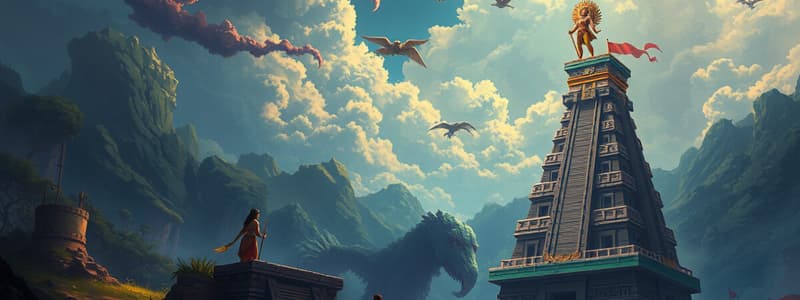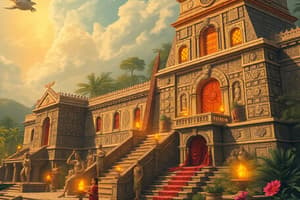Podcast
Questions and Answers
What was the capital of the Aztec Empire?
What was the capital of the Aztec Empire?
- Cuzco
- Cusco
- Tenochtitlan (correct)
- Mexico City (correct)
What were the artificial islands built for farming by the Aztecs called?
What were the artificial islands built for farming by the Aztecs called?
Chinampas
Which civilization was located in the Andes?
Which civilization was located in the Andes?
- Incas (correct)
- Olmecs
- Maya
- Aztecs
Both Aztecs and Incas had centralized governments.
Both Aztecs and Incas had centralized governments.
What was a notable feature of the Inca Empire's infrastructure?
What was a notable feature of the Inca Empire's infrastructure?
Match the following words with their definitions:
Match the following words with their definitions:
The Aztec political structure was ______, while the Inca's was ______.
The Aztec political structure was ______, while the Inca's was ______.
What was the role of human sacrifice in Aztec culture?
What was the role of human sacrifice in Aztec culture?
Both the Aztecs and Incas used a form of tribute.
Both the Aztecs and Incas used a form of tribute.
What was the capital of the Inca Empire?
What was the capital of the Inca Empire?
Which system did both the Aztec and Inca civilizations use for gender roles?
Which system did both the Aztec and Inca civilizations use for gender roles?
What were the Inca's records kept with?
What were the Inca's records kept with?
What was one of the major similarities between the Aztec and Inca civilizations?
What was one of the major similarities between the Aztec and Inca civilizations?
The Aztecs used _______ for farming methods, while the Incas used _______.
The Aztecs used _______ for farming methods, while the Incas used _______.
Flashcards
Aztec Empire
Aztec Empire
Powerful empire in central Mexico (1325-1521 CE)
Tenochtitlan
Tenochtitlan
Aztec capital, built on Lake Texcoco.
Chinampas
Chinampas
Aztec floating gardens for agriculture.
Inca Empire
Inca Empire
Signup and view all the flashcards
Cuzco
Cuzco
Signup and view all the flashcards
Mita System
Mita System
Signup and view all the flashcards
Tribute System
Tribute System
Signup and view all the flashcards
Gender Parallelism
Gender Parallelism
Signup and view all the flashcards
Polytheism
Polytheism
Signup and view all the flashcards
Human Sacrifice
Human Sacrifice
Signup and view all the flashcards
Terrace Farming
Terrace Farming
Signup and view all the flashcards
Suspension Bridges
Suspension Bridges
Signup and view all the flashcards
Quipu
Quipu
Signup and view all the flashcards
Nahuatl
Nahuatl
Signup and view all the flashcards
Quechua
Quechua
Signup and view all the flashcards
Alluyu
Alluyu
Signup and view all the flashcards
Capulli
Capulli
Signup and view all the flashcards
Centralized Government
Centralized Government
Signup and view all the flashcards
Decentralized Government
Decentralized Government
Signup and view all the flashcards
Spanish Conquest
Spanish Conquest
Signup and view all the flashcards
Inti
Inti
Signup and view all the flashcards
Aztec Hierarchy
Aztec Hierarchy
Signup and view all the flashcards
Inca Administration
Inca Administration
Signup and view all the flashcards
Study Notes
Aztecs
- Known as Mexica, established a powerful empire in central Mexico from 1325 to 1521 C.E.
- Notable for Tenochtitlan, built using innovative chinampas, causeways, and canals on Lake Texcoco.
- Forced conquered peoples to provide goods and labor as tribute.
Incas
- Ancient civilization existing from roughly 1200 to 1500 AD in the Andes of Peru.
- Built an extensive network of suspension bridges and roads connecting Central Ecuador to southern Peru.
Similarities Between Aztecs and Incas
- Both civilizations excelled in engineering despite difficult geography.
- Tribute systems: Aztecs demanded military tribute often for human sacrifice, while Incas utilized the mita system for labor.
- Both societies practiced polytheism and constructed monumental architecture.
- Lacked large work animals, metal tools, and the wheel, yet developed centralized governments and armies.
- Both empires ultimately fell to Spanish conquest due to advanced weaponry and diseases.
Social Structures
- Aztecs organized into capulli; Incas into alluyu.
- Exhibited gender parallelism with distinct roles but equal societal value.
- Tribute varied: Aztecs demanded goods, while Incas employed the Mita system.
Political Structures
- Aztecs practiced a decentralized system offering more autonomy to subjects; Incas maintained a strong, centralized government.
- Tribute systems influenced governance and military organization.
- Infrastructure development was crucial for both empires, notably Tenochtitlan for Aztecs and Cusco for Incas.
Human Environment Interaction (HEI)
- Aztecs used chinampas for agriculture; Incas utilized terrace farming techniques.
- Both constructed extensive networks of bridges, roads, and canals to enhance trade and communication.
Cultural Aspects
- Both civilizations emphasized polytheism and conducted human sacrifices.
- Engaged in ceremonial practices that were integral to their societal structure, employing different languages (Nahuatl for Aztecs and Quechua for Incas).
Economic Systems
- Tribute structures pivotal for both economies; Aztecs collected goods while Incas relied on the Mita system for labor.
- Societies involved in labor specialization and trade of produced items.
Technological Innovations
- Aztecs built causeways and canals; Incas excelled with suspension bridges and terrace farming.
- Utilized distinct record-keeping systems: Aztecs had hieroglyphs while Incas employed quipus (knot-based records).
Aztec Capital
- Tenochtitlan, now Mexico City, served as the thriving capital of the Aztec Empire.
Built Chinampas
- Aztecs developed artificial islands for agriculture, known as chinampas, to support their growing population and maximize farming output.
Aztec Empire Overview
- Extended from central Mexico to the border of Guatemala, utilizing tributes of resources from conquered populations.
Aztec Hierarchy
- Structured with an emperor at the top, followed by nobility, commoners, serfs, and slaves.
- Commoners included priests, merchants, and artisans, while serfs were tied to noble lands.
Religion & the Arts
- Religion drove Aztecs to engage in warfare, emphasizing the necessity of human sacrifices to appease gods.
- Artistic expression flourished in temple decorations and writing that celebrated military victories.
Inca Empire Overview
- Dominated the Andes, spanning approximately 2500 miles; Cuzco served as the capital.
- Established through conquests and raiding, creating a strong centralized government.
Inca Administration
- Emperors held immense control over land, agriculture, and resource distribution.
- Implemented step terraces for farming on hilly terrain and enforced tax collection from harvested crops.
Inca Infrastructure
- Developed a network of roads and bridges to connect diverse regions across the empire.
- Emphasized sacrifices to please gods, but on a smaller scale compared to Aztecs.
Inca Labor System
- Mita represented the labor service system, requiring periodic work from households in agriculture, herding, and construction in exchange for state-sponsored feasts.
Gender Parallelism in Empires
- Both empires operated under gender parallelism, with separate yet equally valued roles and responsibilities for men and women.
Differences Between Aztecs and Incas
- Agriculture methods differed: Aztecs used chinampas, while Incas practiced terrace farming.
- Different tribute systems: blood tribute for Aztecs versus labor mita for Incas.
- Aztec emperors viewed as sons of the sun god; Incas worshiped Inti.
- Unique languages: Aztecs spoke Nahuatl; Incas communicated in Quechua.
Studying That Suits You
Use AI to generate personalized quizzes and flashcards to suit your learning preferences.




